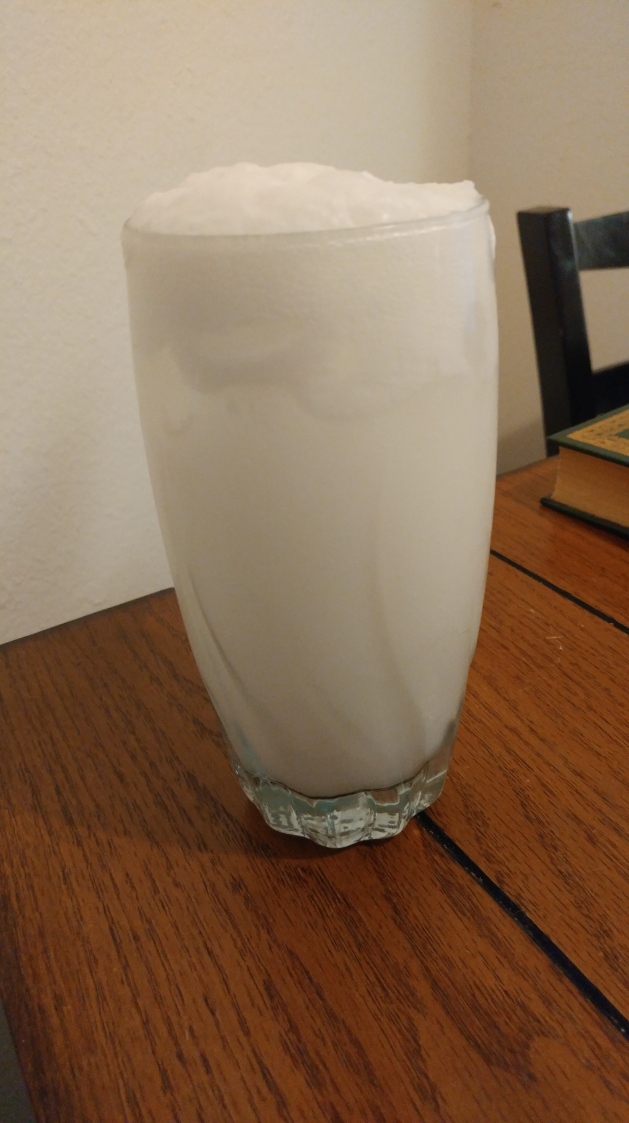Chartreuse is a green-tinted herbal liqueur made by the Carthusian Order (there is also a yellow variety of the liqueur available). The Carthusians arguably have the strictest monastic rule of any holy order in existence. The recipe for the liqueur is of course a secret, and one that has proven resistant to several attempts at emulation and that has survived several suppressions of the Order in France. The liqueur’s intense herbal flavor, which I would characterize in one word as “dank”, easily overpowers its strong 110 proof alcohol content. This is all well and good. But how can we use it to mix cocktails?
The most popular Chartreuse cocktails are variations on the Last Word. This is an excellent drink and rand I recommend it if you have the necessary ingredients on hand.
Chartreuse’s vegetable taste seemed a natural ingredient to a cream cocktail, which gives the drink a mouthfeel to match the complex blend of flavors in the liqueur. I found Chartreuse to be rather like vermouth — it’s easy to ruin a drink with too much of it, but you can always add a splash more if you skimped when mixing. If you’re only a postulant regarding the liqueur — likely given its exotic taste and price tag — keep this in mind when mixing these or any other recipes. You might only want to use half measures when starting out.
After failed attempts to alter Alexander cocktails or use amaretto as an ingredient, I hit upon the sweet, one-note taste of creme de menthe as a suitable companion to Chartreuse’s herbal bouquet.
The Green Goblin
1 part cream
1 part creme de menthe (green)
.75 part Chartreuse (green)
Shake and serve straight up
The taste of mint is heavy up front, but the Chartreuse strongly dominates both the aroma and aftertaste. In general, I found Chartreuse to be effective at creating a strong “undertone” to drinks, as a tincture, rather than as a main ingredient. Again, rather similar to the way I use vermouth.
The “Green Goblin” recipe above immediately brought to mind the question: what if I just add it to a grasshopper cocktail? After all, chocolate liqueur is a quite versatile ingredient. Sure enough, it worked.
The Locust
1 part creme de menthe
1 part creme de cacao
1 part Chartreuse
1 part cream
Shake and serve straight up
The extra ingredient added a definite subtle complexity to this unsophisticated dessert cocktail. Between the two, I think it might be the better recipe — I’m certainly more proud of it.
After trying a recommendation from elsewhere to use Chartreuse in place of vermouth in a martini, I then tried my hand at using it in an Old Fashioned cocktail. And of course it worked.
Old Rule
1 part rye whiskey
.25 parts Chartreuse
1 dash orange bitters
Stir and serve on the rocks
Chartreuse is slightly sweetened, and so eliminates the need to add sugar from elsewhere, though a dash of syrup might be required for a real sweet tooth (though full warning Chartreuse might not be the best purchase for you if you prefer very sweet drinks). Angostura bitters don’t go well with Chartreuse I think, but you can hardly call a drink an old fashioned without some sort of bitters. Orange bitters it is then, but don’t go overboard.
I garnished all of these drinks with basil leaves as they go well with Chartreuse in appearance, aroma, and taste (undoubtedly they are one of the ingredients, though that’s not saying much).

